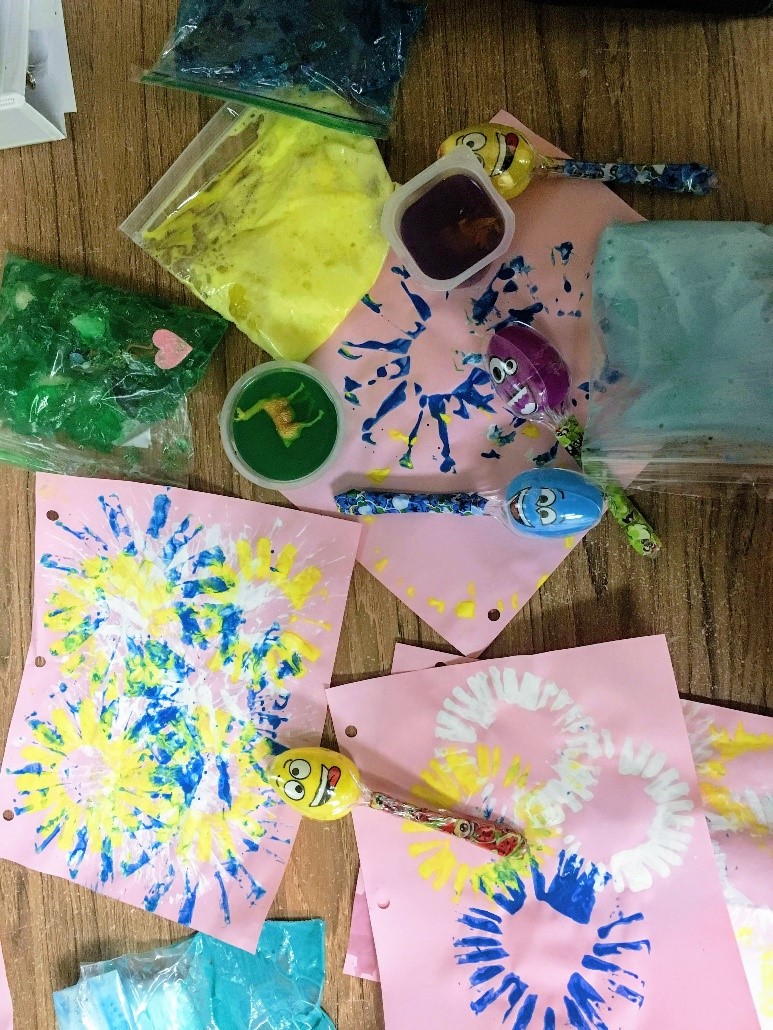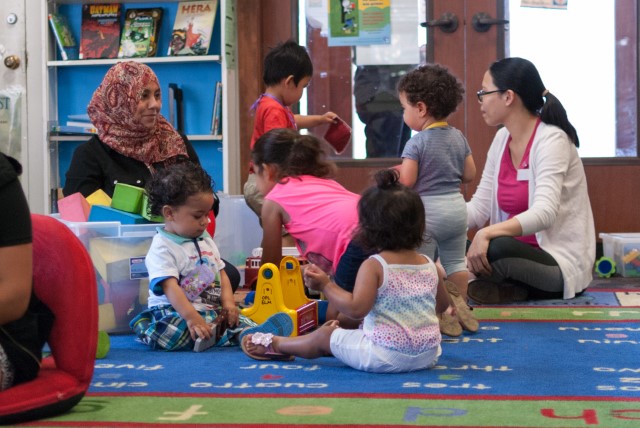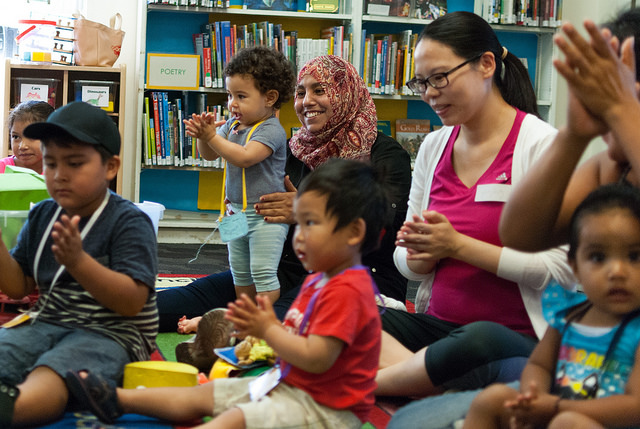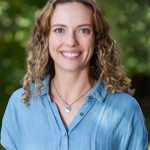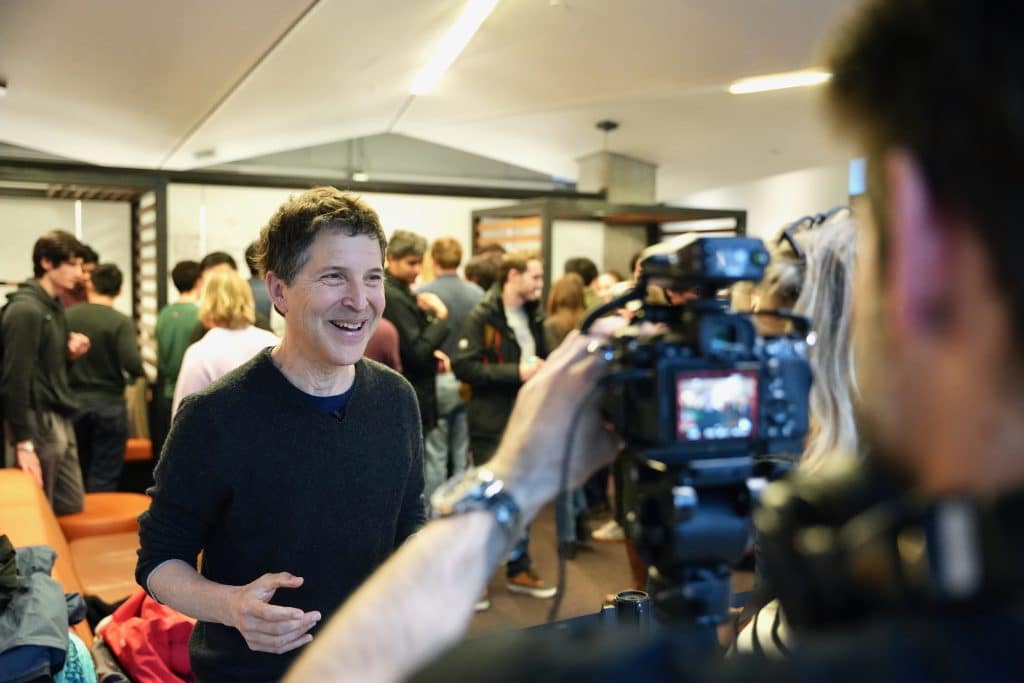Early one Friday morning in March, we embarked on a road trip down Highway 101, headed for Santa Maria, California. This growing city on the Central Coast is notable for its agriculture, wine industry, and Santa Maria-Style barbeque. For some, it is a pit stop on their way to the neighboring cities of Santa Barbara and San Luis Obispo. However, for Program Analyst Diana Garcia, it is the community where she grew up and where her family still lives. Santa Maria is also one of the sites selected by Visión y Compromiso, a Packard Foundation grantee, to deliver a series of trainings for family, friend, and neighbor (FFN) caregivers of young children.

Growing up in Santa Maria, it was not uncommon for Diana’s mother to care for the children of neighbors and family members while their parents went off to work, which for many involves working in the strawberry and broccoli fields. That is why Diana lit up with joy when she learned that Visión y Compromiso would be providing valuable training to FFN caregivers in her community.
Visión y Compromiso is dedicated to improving the health and well-being of under-resourced and underrepresented communities by providing support, training, and leadership development to promotoras and community health workers (collectively, “promotores”) throughout California. At the core of their model, promotores are community members who develop trusting relationships and share personal experiences, information, and resources in culturally and linguistically relevant ways drawing from people’s own strengths to transform their communities into healthier, more vibrant places for all families to live, work, and play.
The Packard Foundation team observed Visión y Compromiso project manager Hugo Ramirez and project coordinator Alejandra Reyes, as they led the fourth week of an 8-week long program held every Thursday and Friday evening. Facilitated entirely in Spanish, the sessions are designed to introduce FFN caregivers to information about how children develop and learn, to offer practical guidance and activity ideas, and to strengthen their confidence as influential adults in the lives of the children they care for. In this three-hour session, caregivers learned about the importance of gross-motor and fine-motor play, asking open-ended questions, and incorporating their culture into the interactions they have with children every day. The energy and excitement in the room was infectious. One caregiver brought a ziploc bag filled with bright green Jell-o interspersed with flower petals and tiny plastic dinosaurs. She was inspired by the activity ideas showcased during the previous night’s session to help children develop fine-motor skills and promote exploration with new textures, and experimented with making her own the very next day. Her classmates were impressed by her creativity and reassured that they could make their own version at home. Through this activity, they could introduce children to science by making the Jell-o together, promoting language skills by asking question such as how does the Jell-o feel compared to the dinosaurs? and encouraging inquiry-based learning by asking children to predict and investigate what would happen if they squeeze the bag.


Both Diana and Katie have previous experience working with young children, Diana as a pre-k teacher in New York, and Katie as an AmeriCorps classroom coach in San Mateo County. Before this visit, we had read about the curriculum developed by staff from Visión y Compromiso and heard some reflections from the first two cohorts that completed their training. Seeing the curriculum and Alejandra and Hugo in action was completely different experience than reading or hearing about it second hand. The foundation of their approach to training entails strengthening the confidence of FFN participants by affirming their knowledge and the valuable role they play in the lives of the children in their care. One caregiver shared how the classes have helped her better understand the needs of an active boy in her care. At first, she felt the need to limit his physical play but now she understands that he is likely a kinesthetic learner and now looks for ways to incorporate educational activities into active play. This shift in mindset helped her to see the little boy as a different type of learner, which relieved some of the stress and frustration she experienced when trying unsuccessfully to convince him to do more traditional, quiet activities.
During our time as teachers, we both attended professional development trainings and some were much better than others. Sitting in the trainings in Santa Maria and the next day in Santa Barbara, we recognized several aspects that reminded us of the truly great trainings we attended. We were struck by the way Hugo and Alejandra seamlessly connected complex material about child development to concrete examples of how to support development with specific activities. Translating theory into practice is one of the core components of high-quality professional development, which the Foundation strives to support through its Early Learning strategy.
One example of this was a reading exercise that the group practiced. After splitting up into three small groups, caregivers role-played reading a new book aloud to the group and asking open-ended questions while the others impersonated children. Throughout this activity, Alejandra and Hugo walked around and asked guiding questions to encourage the caregivers to think about how to ask questions that would extend the children’s learning. “What happened in the book? How does this character feel? When have you felt that way?” When reading the book Si Le Das un Panqueque a Una Cerdita [If You Give a Pig a Pancake], they could ask: Would you ever give a pig a pancake? What do you think would happen? This hands-on activity allowed caregivers to think about how to apply what they were learning to the young children they care for, and small changes they could make to their normal routines.

Another compelling aspect of the sessions was to discuss the importance of culture and helping children develop a positive cultural identity. Although Santa Maria and Santa Barbara are largely composed of Latinx families, when children enter the formal education system their culture is not often celebrated or included as a component of the curriculum. Many of the caregivers shared anxiety about exposing the children in their care to Spanish or Mixtec, an indigenous language, for fear that it would interfere with their ability to learn English. However, Alejandra and Hugo dispelled some of the myths of bilingual children and asked caregivers to think of their earliest childhood memories connected to songs and stories from their home countries. Alejandra shared some examples, including “El Piojo y La Pulga” [“The Lice and the Flea”], and everyone in the room began singing along and sharing their childhood favorites. Soon the room was full of joy and laughter, as the caregivers recalled the rhymes and songs their parents and grandparents shared with them. By the end of the session, we noticed there was a lot more excitement in the room and even the quieter participants began joining the discussion and sharing their cultural reflections.
While Katie and Diana had ready access to professional development trainings in the formal care setting of preschool classrooms, FFN caregivers caring for children in informal settings like their homes rarely have the opportunity to access such trainings. That is why the Packard Foundation developed a strategy devoted to FFN caregivers and informal care settings. The strategy seeks to achieve three objectives:
- Raise greater awareness about the important role FFN informal caregivers play in the early learning and development of young children;
- Strengthen FFN informal caregivers’ early learning knowledge and expertise to better support children’s learning; and
- Improve the quality of care in informal settings to help ensure more children are on track and ready for school by age five.
By supporting grantees like Visión y Compromiso, we are learning about the most effective ways to reach FFN caregivers, the information that they want to know, and how best to support them in improving the quality of their interactions with young children. The key to the informal care strategy, and to all of the strategies in the Children, Families, and Communities program, is the quality of adult-child interactions.
So, what does quality mean and how do we recognize it when we see it? To help define quality, the Foundation supported the Early Learning Lab in bringing together experts in child development to identify the five critical practices that ensure optimal interactions between adults and young children. We call them “The Big Five Priority Practices” and they can be implemented in any and all environments where adults interact with children. The Big Five include:
- providing rich learning activities that build on the child’s interests;
- reading, singing, and telling stories;
- knowing the stage of a child’s development and what will come next;
- creating nurturing relationships and using positive guidance; and
- being responsive and expanding verbal and non-verbal communication.
We were excited to see elements of The Big Five throughout the sessions facilitated by Hugo and Alejandra. They covered the importance of reading, singing, and telling stories during the reading aloud exercise and reinforced it during the conversations about culture and using songs and rhymes to share culture with children. They practiced expanding verbal communication by asking open-ended questions to extend learning during a painting activity with recycled toilet paper rolls. Alejandra shared a variety of activities that the FFN caregivers could easily re-create at home, providing lots of inspiration for the types of rich learning activities that can be customized based on a child’s interests.

The two days we spent visiting with informal caregivers engaged in a quality training reinforced for us the critical impact that nonprofits like Vision y Compromiso can have in ensuring that FFN caregivers have the skills they need to create nurturing environments. In the coming years, the Packard Foundation’s goal is to continue to learn how to effectively communicate with FFN caregivers and support them with resources and best practices. Through funding this innovative work, the Packard Foundation hopes to highlight the important role that FFN caregivers play in the lives of thousands of children across the state, and increase the support available to advance these collective efforts to improve the quality of care provided.


